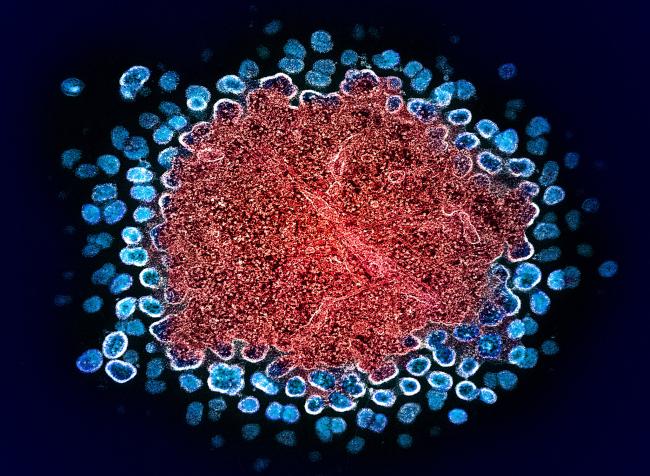Progress toward an eventual HIV vaccine
December 13, 2022
Progress toward an eventual HIV vaccine
At a Glance
- An experimental HIV vaccine elicited broadly neutralizing antibody precursors in people.
- With further development, the approach could lead to an effective vaccine strategy for HIV and AIDS.

More than 1 million new HIV infections occur each year. Ending the global HIV/AIDS pandemic will require an effective HIV vaccine. Vaccines work by inducing the immune system to make antibodies that can neutralize a particular pathogen. But doing so for HIV has been challenging because there are countless variants worldwide, and the immune system doesn’t normally make antibodies that can protect against a wide range of them.
More than a decade ago, researchers at the Vaccine Research Center of NIH’s National Institute of Allergy and Infectious Diseases discovered a class of rare antibodies called broadly neutralizing antibodies (bnAbs) against HIV. These could neutralize many HIV strains at once. The bnAbs have been shown to prevent HIV infection in animals and humans. But inducing bnAbs with a vaccine has proven difficult. This is because bnAb-precursor B cells—the immune cells that develop into bnAb-producing B cells—are only rarely activated by the envelope proteins that form a protective coating for HIV.
One strategy to produce bnAbs involves specifically stimulating these rare precursor B cells. To do this, researchers led by Dr. William Schief at the Scripps Research Institute engineered a molecule based on a region of the HIV envelope protein called the CD4 binding site. They developed a modified protein to prime the precursor B cells to react. The protein, called eOD-GT8, was designed to incorporate into a self-assembling nanoparticle with 60 copies. The nanoparticle vaccine was previously shown to induce production of bnAb precursors in mice.
Based on this evidence, a research team led by Drs. Juliana McElrath at the Fred Hutchinson Cancer Center, Adrian McDermott at NIH’s Vaccine Research Center, and Schief conducted a phase 1 clinical trial of the eOD-GT8 vaccine to begin assessing its safety and efficacy in people. Results appeared in Science on December 2, 2022.
Forty-eight participants were immunized with either a low or high dose of the vaccine or a placebo. Immunization consisted of two doses, given eight weeks apart. The vaccine had a favorable safety profile, with no serious adverse events reported.
Before and after vaccination, the researchers measured the presence in participants’ blood and lymph nodes of bnAb-precursor B cells targeting eOD-GT8. They found that these cells increased in 97% of vaccine recipients after at least one of the two doses. Frequencies of these B cells increased by more than 500-fold compared to before vaccination.
The team also examined the receptors that B cells use to recognize pathogens. These receptors resemble antibodies and recognize their targets in a similar way. Receptors on the eOD-GT8-targeting bnAb-precursor B cells shared several molecular features with bnAbs. The team also saw early steps in the development of bnAbs. These include an increase in mutations in the receptor genes after the second vaccine dose and an increase in the affinity of the receptors for the vaccine.
These findings establish proof of concept and a crucial first step for the strategy of eliciting bnAbs against HIV. But this priming vaccine alone cannot induce production of mature bnAbs. Booster vaccines will be needed to elicit bnAb production and protection against HIV. The results support further development of such boosters.
“This trial and additional analyses will help inform design of the remaining stages of a candidate HIV vaccine regimen—while also enabling others in the field to develop vaccine strategies for additional viruses,” McElrath says.
—by Brian Doctrow, Ph.D.
Related Links
- “Slow” Vaccine Delivery Improves Immune Response To HIV
- Combination Antibody Treatment For HIV
- Experimental mRNA HIV Vaccine Shows Promise in Animals
- Antibody Combination Suppresses HIV
- Test Vaccine Active Against Many HIV Strains
- Engineered Antibody Protects Monkeys From HIV-Like Virus
- HIV Vaccine Progress in Animal Studies
- Antibodies Protect Human Cells from Most HIV Strains
- HIV and AIDS: Know the Facts
- HIV/AIDS
- HIV Info
References
Vaccination induces HIV broadly neutralizing antibody precursors in humans. Leggat DJ, Cohen KW, Willis JR, Fulp WJ, deCamp AC, Kalyuzhniy O, Cottrell CA, Menis S, Finak G, Ballweber-Fleming L, Srikanth A, Plyler JR, Schiffner T, Liguori A, Rahaman F, Lombardo A, Philiponis V, Whaley RE, Seese A, Brand J, Ruppel AM, Hoyland W, Yates NL, Williams LD, Greene K, Gao H, Mahoney CR, Corcoran MM, Cagigi A, Taylor A, Brown DM, Ambrozak DR, Sincomb T, Hu X, Tingle R, Georgeson E, Eskandarzadeh S, Alavi N, Lu D, Mullen TM, Kubitz M, Groschel B, Maenza J, Kolokythas O, Khati N, Bethony J, Crotty S, Roederer M, Karlsson Hedestam GB, Tomaras GD, Montefiori D, Diemert D, Koup RA, Laufer DS, McElrath MJ, McDermott AB, Schief WR. Science. 2022 Dec 2;378(6623):eadd6502. doi: 10.1126/science.add6502. Epub 2022 Dec 2. PMID: 36454825.
Funding
NIH’s National Institute of Allergy and Infectious Diseases (NIAID); International AIDS Vaccine Initiative (IAVI); Bill and Melinda Gates Foundation Collaboration for AIDS Vaccine Discovery; Swedish Research Council; Ragon Institute of MGH, MIT, and Harvard.


